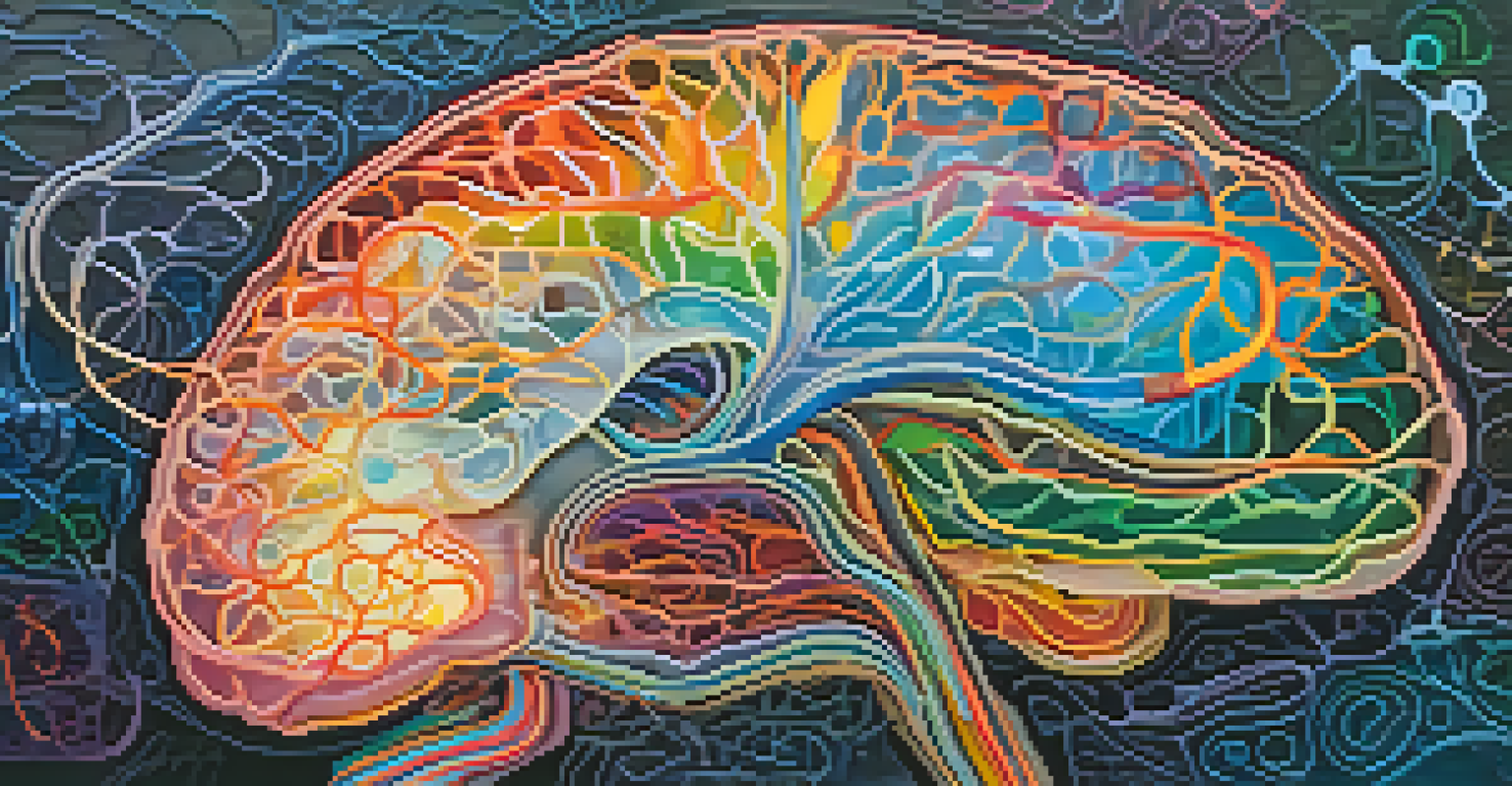Entheogens in Modern Therapy: Benefits and Risks

What Are Entheogens and Their Historical Uses?
Entheogens are substances that can induce altered states of consciousness, often used in spiritual or healing practices. Historically, cultures around the world have utilized these substances, like psilocybin mushrooms and ayahuasca, in rituals aimed at personal growth and mental clarity. By tapping into deep-seated beliefs and experiences, these substances have played significant roles in various indigenous traditions.
The use of psychedelics in a therapeutic context is not about escaping reality; it is about confronting it with a new perspective.
In the modern context, the term 'entheogen' emphasizes a spiritual or therapeutic intent behind usage, distinguishing them from recreational drugs. This reframing has led to a resurgence of interest in how these substances can complement psychological therapy today. It’s essential to appreciate this historical context to understand their potential in contemporary practices.
As we delve into the modern therapeutic landscape, it’s crucial to recognize the balance between tradition and innovation. The resurgence of interest in these substances is not just a trend; it reflects a broader search for alternative mental health solutions. With mental health challenges on the rise, exploring ancient practices through a modern lens could provide much-needed insights.
The Therapeutic Benefits of Entheogens
Recent research has highlighted numerous benefits of using entheogens in therapeutic settings. Studies show that substances like psilocybin can significantly reduce symptoms of depression and anxiety, offering relief when traditional treatments may falter. This potential stems from their ability to foster profound introspection and emotional processing.

Moreover, entheogens can help patients confront difficult emotions and trauma, facilitating a unique healing journey. For many, the experience can lead to a sense of interconnectedness and enhanced emotional resilience, which are invaluable during recovery. This transformative potential has caught the attention of therapists and researchers alike.
Entheogens Offer Healing Potential
Research shows that entheogens like psilocybin can significantly alleviate symptoms of depression and anxiety, providing new avenues for mental health treatment.
However, the therapeutic use of these substances is not just about the chemical effects; it's also about the setting and guidance provided during the experience. A supportive environment, often termed 'set and setting,' plays a crucial role in determining the outcome of the experience. Thus, when integrated thoughtfully into therapy, entheogens can offer groundbreaking benefits to individuals seeking healing.
Risks Associated with Entheogen Use
Despite the promising benefits, it's crucial to acknowledge the risks that come with entheogen use. Not all individuals respond positively to these substances; some may experience heightened anxiety or paranoia, particularly if they have a history of mental health issues. This underscores the importance of thorough screening and understanding one's mental health background before considering entheogenic therapy.
Entheogens are a window into the unconscious mind, offering profound insights that can lead to healing and transformation.
Additionally, the legality of these substances varies widely, which can complicate access and research. In some regions, the use of entheogens remains illegal, limiting the ability to study their effects comprehensively. This legal uncertainty can lead to unsafe practices and unregulated environments, posing further risks to individuals seeking help.
Moreover, the experience itself can be unpredictable. While many report positive outcomes, others may encounter challenging experiences, often referred to as 'bad trips.' Having a trained professional present during sessions can mitigate these risks, helping guide individuals through difficult moments. Thus, understanding both benefits and risks is essential for anyone considering this therapeutic path.
The Science Behind Entheogens: What Research Says
Scientific interest in entheogens has surged in recent years, with numerous studies exploring their therapeutic potential. For instance, research at institutions like Johns Hopkins University has demonstrated that psilocybin can lead to lasting improvements in mood and anxiety for cancer patients. Such findings have helped to legitimize the use of these substances in therapeutic contexts.
Neuroscientific studies reveal that entheogens may promote neuroplasticity—the brain's ability to reorganize itself—allowing for new thought patterns and emotional responses. This could explain why some individuals experience profound shifts in perspective following their use. By facilitating new connections, entheogens may help break the cycles of negative thinking often associated with mental health disorders.
Importance of Set and Setting
The mindset and physical environment during entheogenic experiences are crucial in shaping outcomes, emphasizing the need for a supportive therapeutic setting.
However, while the research is promising, it's still in its early stages. More extensive clinical trials are needed to fully understand the long-term effects and best practices for their use. As the scientific community continues to explore these avenues, the hope is to develop safe, effective protocols for integrating entheogens into therapeutic practices.
The Role of Set and Setting in Entheogenic Experiences
One of the most critical factors influencing the effects of entheogens is the concept of 'set and setting.' 'Set' refers to the individual's mindset going into the experience, while 'setting' pertains to the physical and social environment in which it's conducted. Together, these elements can significantly shape the outcome of an entheogenic journey.
A supportive, calm environment can enhance positive experiences and promote healing. Conversely, a chaotic or uncomfortable setting can lead to feelings of anxiety and distress. For this reason, many therapists emphasize the importance of creating a safe space for clients to explore these substances, often involving trained professionals to guide the experience.
Understanding and preparing both the set and setting can make all the difference in outcomes. This approach not only emphasizes the safety of the experience but also empowers individuals to take an active role in their healing journey. Thus, recognizing the importance of these elements is vital for anyone considering entheogenic therapy.
Legality and Accessibility of Entheogens
The legal landscape surrounding entheogens is complex and varies widely by location. In some areas, substances like psilocybin and MDMA are being decriminalized or approved for therapeutic use, while in others, they remain strictly regulated or illegal. This inconsistency can create barriers for individuals seeking treatment and limit access to potentially life-changing therapies.
As public interest and scientific research grow, advocacy for the legalization and regulation of entheogens in therapeutic contexts also increases. Many believe that a regulated framework could ensure safety and efficacy while providing access to those in need. This ongoing dialogue highlights the importance of balancing safety with the potential benefits of these substances.
Legal Barriers Impact Access
The varying legality of entheogens across regions creates obstacles for individuals seeking treatment, highlighting the need for informed advocacy and regulation.
Understanding the legal implications is crucial for anyone interested in exploring entheogenic therapy. Individuals must stay informed about their local laws and seek guidance from professionals who are knowledgeable about the regulations. As we move forward, the hope is that increased awareness will lead to more comprehensive policies that support mental health treatment options.
Looking Ahead: The Future of Entheogens in Therapy
As we look to the future, the potential of entheogens in therapy continues to spark excitement and debate. With growing evidence supporting their benefits, more mental health professionals are beginning to integrate these substances into their practices. This shift could signify a broader acceptance of alternative treatments in the mental health field.
Moreover, as research expands, we can expect to see more refined approaches to using entheogens. This may include developing specific protocols for different conditions, enhancing safety measures, and focusing on the therapeutic relationship between patient and guide. Such advancements could pave the way for a new era in mental health treatment.

Ultimately, the future of entheogens in therapy hinges on ongoing research, public perception, and regulatory developments. As we continue to explore these ancient practices in modern contexts, the hope is to create a holistic approach to mental health that embraces both traditional wisdom and scientific innovation.